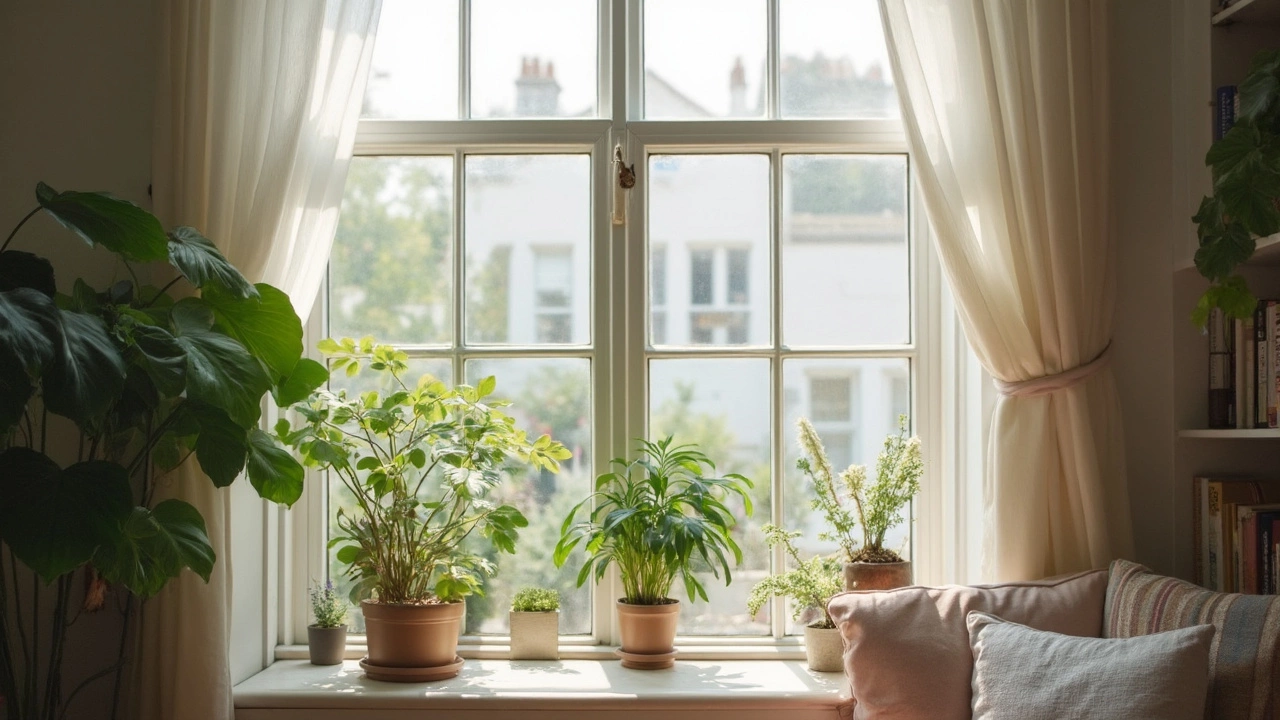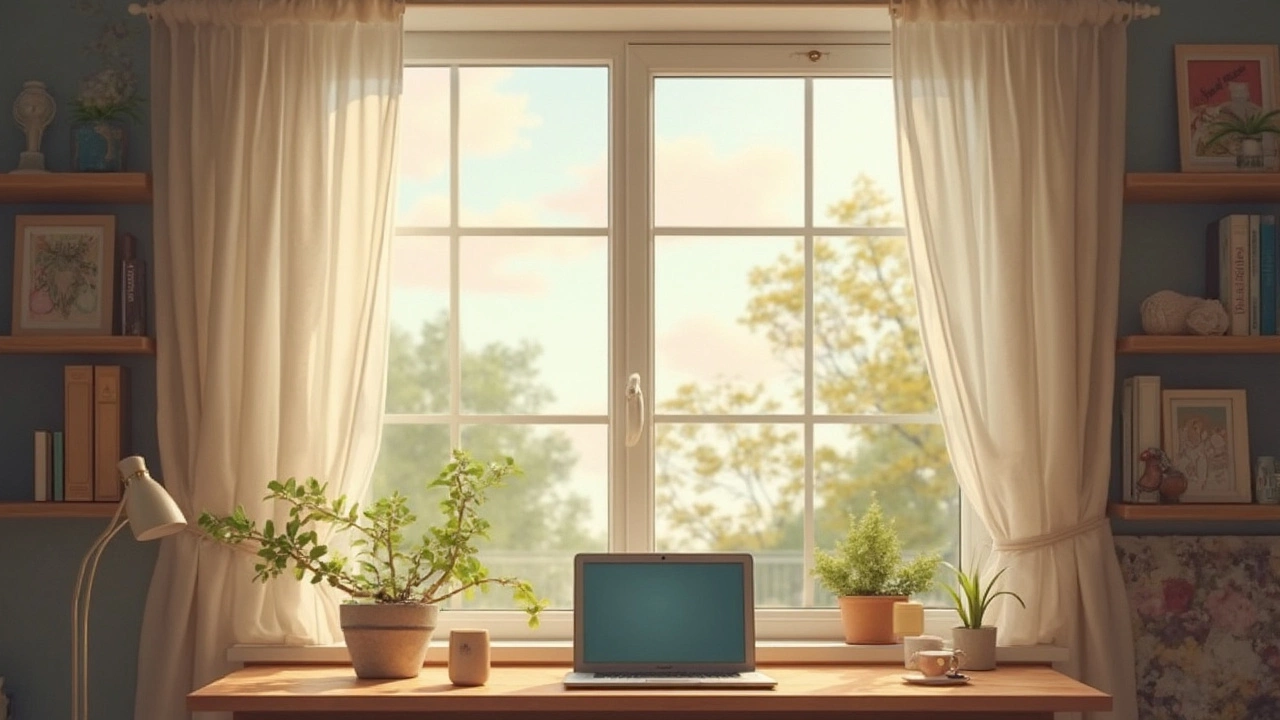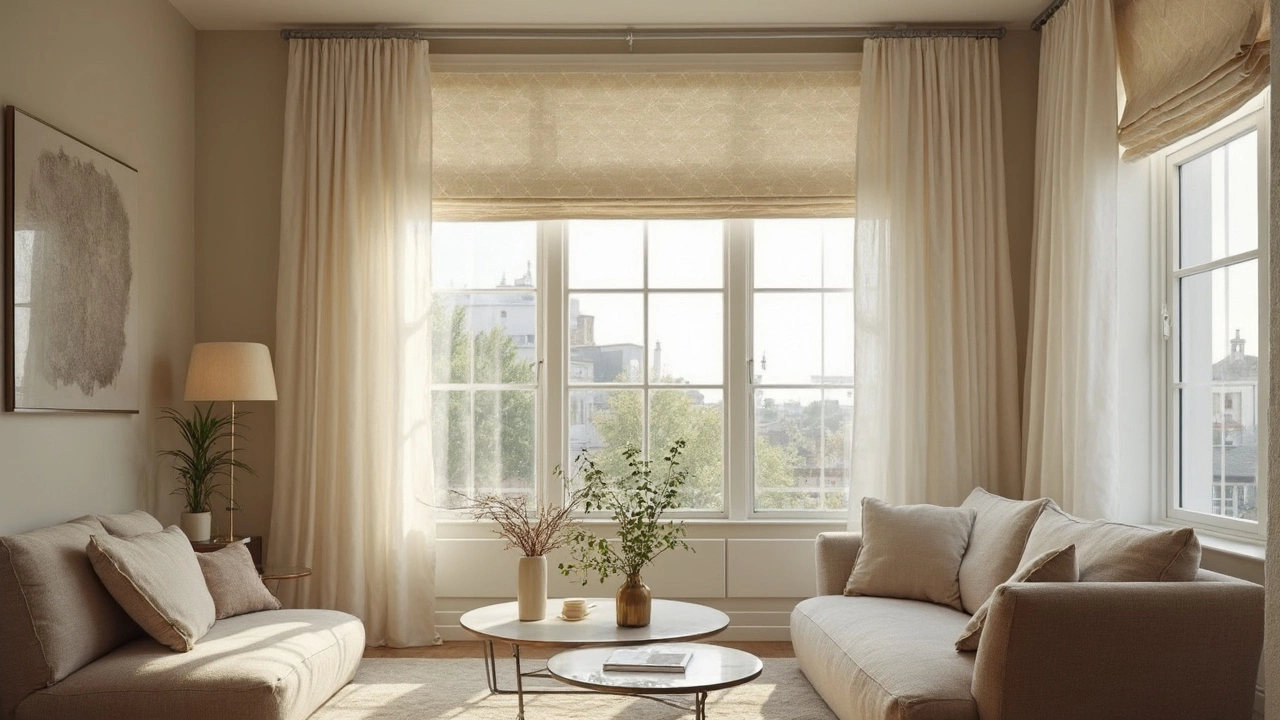Windows Private but Bright: Curtain Tricks for Light and Secrecy
 Jun, 14 2025
Jun, 14 2025
If you want privacy but hate dingy rooms, you're not alone. Nobody loves that blackout cave look all day. The good news? There are ways to keep your windows private and still catch every sunbeam.
Sheer curtains are a go-to for this reason. They blur the outside but still let daylight pour in. Hang a sheer panel, and you can go about your day without worrying the whole street is watching. Even budget-friendly options from local home stores work wonders.
Worried sheers aren’t enough? There’s more to consider—like double-layering with heavier curtains for nighttime, or trying out newer privacy films that stick straight onto the glass. Let’s break down every choice that actually works in regular homes, not just fancy design magazines.
- Sheers: Your First Line of Defense
- Layering Curtains: The Double-Act
- Alternative Privacy Tricks (Films and Frosting)
- Placement and Length: Small Adjustments, Big Effects
- Common Mistakes to Avoid
Sheers: Your First Line of Defense
If you want to block wandering eyes but still want sunlight, sheer curtains get the job done better than most people realize. Sheers use a loose weave that diffuses daylight across the room, so it looks bright but not overexposed. That means you get privacy without sacrificing your windows’ best feature—the light.
Here’s something not everyone knows: during the day, sheers give one-way privacy. Outsiders can barely catch a shadow, while you see your own space lit up. When it gets dark and your lights are on, privacy levels drop, so pairing sheers with a heavier layer for night is smart.
Sheer curtains come in plenty of fabrics—polyester, linen blends, even recycled materials. Polyester ones last longer and are easier to wash, but linen gives a more laid-back look. You’ll also find them in loads of colors, but light grays, ivories, and soft whites work best to spread daylight without glare.
Setting up sheers is simple:
- Hang them close to the ceiling to make your room feel taller and brighter.
- Make sure they’re 1.5 to 2 times the window’s width, so the fabric gathers instead of sitting flat and see-through.
- Pair with blackout or light-blocking curtains on the same rod for evenings.
- If privacy is super important, layer two sets of sheers at different densities.
Sheers are cost-effective too. Big chain stores like IKEA and Target carry sheer panels for less than $15 a pair. If you rent, no need to drill holes; tension rods usually hold sheers just fine on most windows.
| Sheer Fabric | Look | Price Range (per panel) | Best Use |
|---|---|---|---|
| Polyester | Sleek, modern | $6–$20 | Busy rooms, homes with kids/pets |
| Linen blend | Soft, relaxed | $10–$30 | Bedrooms, cozy corners |
| Recycled fibers | Eco-friendly, varied textures | $12–$35 | Eco-conscious spaces |
If you’re just getting started, stick to basics: grab a two-pack of polyester sheers, get a rod that’s at least 6 inches wider than your window on each side, and enjoy way more sunlight with less worry about who’s watching.
Layering Curtains: The Double-Act
Layering is where you really win at window privacy and daylight. Basically, you pair two sets of curtains—sheers for daytime and something heavier for the hours when it’s dark out and your lights are on. This is a trick most hotels use, and for good reason: you control exactly how much light and privacy you want, any time.
The go-to setup starts with a sheer curtain next to the glass and a traditional curtain or blackout drape on top. You open the heavier curtain in the day to catch all the sunlight, while the sheer stays shut and keeps wandering eyes out. At night, you close both. No spotlight effect from your TV, no worries.
- Choose a privacy curtain with a tight weave or blackout lining if your window faces a busy area.
- Mount a double rod (most DIY stores sell them cheap) if you want to slide each curtain independently.
- Mix textures and colors for both function and style—go white or cream for the sheer if you want a ‘brighter’ look.
What’s cool is you can change out the heavier curtain by season, or just for a quick room update. This is super flexible for renters since you’re not changing anything permanent about the window.
| Layer Type | Purpose | Light Control |
|---|---|---|
| Sheer | Privacy during the day | Lets in up to 80% natural light |
| Heavier Curtain | Nighttime privacy & insulation | Blocks 90–99% of light, depending on fabric |
If you use blackout on top, you’ll also get better temperature control and noise reduction. Just remember: don’t go so thick you end up resenting the cave vibe. Stick to the double-act and open up when the sun comes out.

Alternative Privacy Tricks (Films and Frosting)
Sheer curtains can only do so much, especially if you’ve got ground-floor windows or nosey neighbors right across the street. That’s where window films and glass frosting step in. These options keep you hidden but don’t steal away your natural light—literally the best of both worlds.
Privacy window films come in tons of styles—from basic frosted to cool geometric patterns and even mirrored finishes. The frosted type is super popular because it blurs anything behind the glass, but sunlight still flows through easily. Most films stick on with just water, so you don’t need fancy tools or a pro installer.
Static-cling film is the easiest to use for renters. Just cut to size, spray the window, and press it on. If you mess up, pull it off and start over—no sticky mess. Permanent frosted spray (like Rust-Oleum’s Frosted Glass) works too, but it actually changes your window until you scrape it off. Go for sprays only if you’re not worried about getting your deposit back.
| Product Type | Light Transmission (%) | Privacy Level (Day) | Removability |
|---|---|---|---|
| Static-Cling Frosted Film | 80-90 | High | Easy |
| Mirrored Film | 75-85 | Very High* | Moderate |
| Frosted Glass Spray | 75-90 | High | Hard |
*Mirrored film offers lots of privacy during the day but acts like a regular window at night if your lights are on. You’ll still want a curtain for evenings.
- Always clean your windows first or the film won’t stick well and might peel.
- Cut the film slightly larger than your window pane so it fits edge-to-edge, then trim excess for a clean look.
If you want a quick fix that doesn’t involve any shopping, you can even fake a frosted look using a solution of cornstarch and water. Brush it on, let it dry, and enjoy privacy in minutes. This hack isn’t permanent, but handy if you’re in a pinch or still choosing your long-term look.
Compared to standard privacy curtains, films and sprays are lightweight, modern, and leave no fabric to dust. Films really shine in bathrooms, kitchens, or anywhere you want sunlight with zero audience.
Placement and Length: Small Adjustments, Big Effects
You might think curtains are one-size-fits-all, but little changes in where and how you hang them make a huge difference. Placement and length actually decide how much privacy and light you get. Skip the "just wing it" approach and you'll see a big boost in both looks and function.
Start with rod placement. Mount your curtain rod a few inches above your window frame—usually 4 to 6 inches higher. This little trick makes the window look taller and helps light filter in from the top, even with the curtains partly closed. For width, extend the rod a few inches past each side of the window. That way, when you pull back the curtains, you’re not blocking precious sunlight.
Now about length. For privacy curtains, you want panels that reach at least the bottom of the window sill. Floor-to-ceiling panels look sharp and block views from all angles, which is especially handy in ground-floor rooms. If you're worried about dust, stopping just below the window does the trick too.
Want a visual? This table shows how placement and length combos affect privacy and light in real-world settings:
| Placement & Length | Privacy Level | Natural Light |
|---|---|---|
| Rod 6" above frame, sheer to floor | Good during day | High |
| Rod at frame, curtain to sill | Medium | Medium |
| Floor-to-ceiling blackout + sheer layer | Great (night & day) | Adjustable |
Don’t forget: if you live on a busy street, angle the curtains a bit or overlap two panels. This blocks people from peeking in from the side. These tweaks cost next to nothing but pay off big in privacy and daylight. It’s the difference between a smart setup and a sad, half-lit room.

Common Mistakes to Avoid
Getting privacy and daylight just right takes a little more thought than you’d expect. Slip-ups are easy to make, but fixing them isn’t hard once you know what goes wrong most often.
- Privacy curtains aren’t always enough on their own. A lot of folks buy a single layer of sheer fabric and call it a day. The problem? Walk by at night with your inside lights on, and your living room may turn into a fishbowl. Always check how your windows look outside after sunset if you use only sheers.
- Hanging curtains too short or too narrow. Curtains that barely cover your window’s width don’t block angles where neighbors could peek in. Measure a few extra inches beyond each side and hang closer to the ceiling to get more coverage and add height to your space.
- Picking the wrong material. Not every see-through fabric softens incoming light without killing your privacy. Some cheaper sheers are almost invisible, especially after washing. Look for ones labeled as privacy or voile, and check reviews before buying.
- Skipping the test run. Take a minute and walk around outside at various times of day—and especially at night—to see what’s visible from the street. Your privacy fix could be less private than you think.
- Ignoring window orientation. South-facing windows get blasted by sunlight and can fade curtains fast. A light-blocking liner behind your sheers boosts privacy and protects fabric.
Check out this quick cheat sheet on privacy mistakes and their impact:
| Mistake | Effect | Fix |
|---|---|---|
| Only using sheers | Room fully visible at night | Add a blackout or light-filtering layer |
| Wrong curtain width | Gaps on sides, loss of privacy | Extend rod at least 4" past frame |
| Poor material choice | Too much light or no privacy | Look for labeled privacy fabrics |
| No outdoor check | Missed privacy blind spots | Test from outside at night |
| Ignoring sun direction | Faded, worn-out curtains | Add liner or use UV-blocking film |
Most people make one of these mistakes before they figure out their sweet spot. Tweaking your setup fixes privacy fast and doesn’t mean giving up the sunlight you want.